Understanding Creative Commons licensing helps you legally share and adapt content while respecting creators’ rights. It provides clear rules about what you can do, like crediting authors, using works commercially, or modifying them. Different licenses have specific restrictions, such as NonCommercial or NoDerivatives, which you need to guarantee. Mastering these details ensures your projects stay legal and respectful. Keep exploring to uncover more about how these licenses affect your design work.
Key Takeaways
- Creative Commons licenses allow designers to share and modify work legally while retaining specific rights.
- Understanding license types (e.g., Attribution, ShareAlike, NonCommercial) ensures compliance and proper use.
- Proper attribution is essential, including crediting the creator and linking to the license.
- ShareAlike licenses promote open collaboration but require derivatives to have similar licenses.
- Recognizing restrictions like NonCommercial or NoDerivatives helps avoid legal and ethical issues in projects.
What Are Creative Commons Licenses and Why Do They Matter for Designers
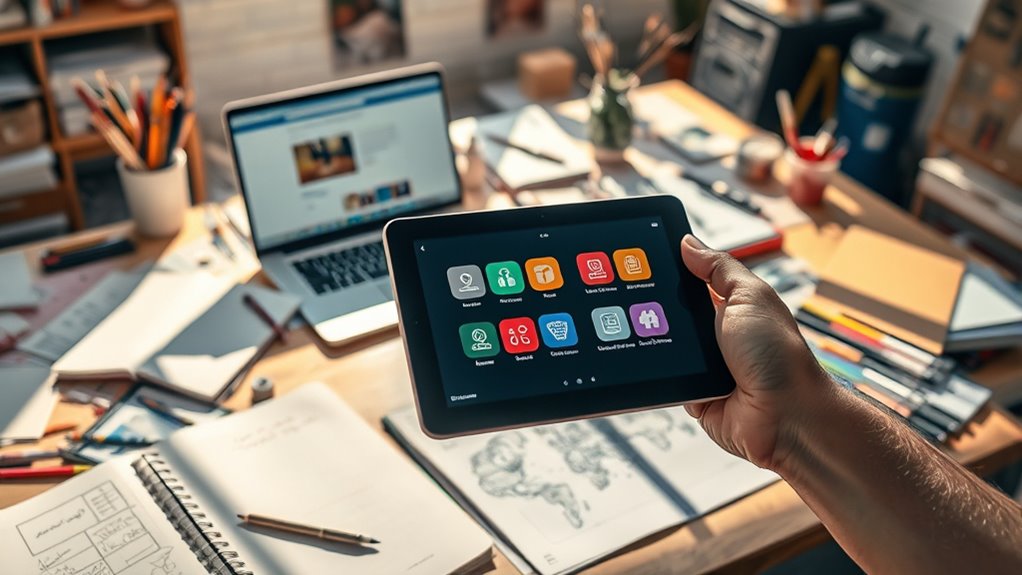
Creative Commons licenses are legal tools that allow creators to share their work with specific permissions while retaining certain rights. As a designer, understanding these licenses helps you know how you can legally use and adapt others’ work. They clarify what you’re allowed to do—whether that’s sharing, modifying, or commercializing content—without risking copyright infringement. This transparency saves you time and legal trouble, especially when sourcing images, fonts, or other assets. By respecting license terms, you build ethical practices and foster collaboration within the creative community. Knowing how these licenses work empowers you to make informed decisions about using resources legally and ethically, ultimately enhancing your professionalism and protecting your projects from legal issues. Additionally, familiarizing yourself with popular apps for tracking and managing licenses can streamline the process of ensuring compliance. Understanding license categories helps you choose the appropriate license type for your projects and avoid unintentional violations. Furthermore, being aware of necessary cookies and their role in tracking usage can assist in managing licensing data more effectively. Recognizing the terms of use associated with different licenses ensures proper attribution and adherence to legal requirements. For example, exemptions from copyright are important to recognize when considering usage rights and limitations.
The Six Main Types of Creative Commons Licenses Explained
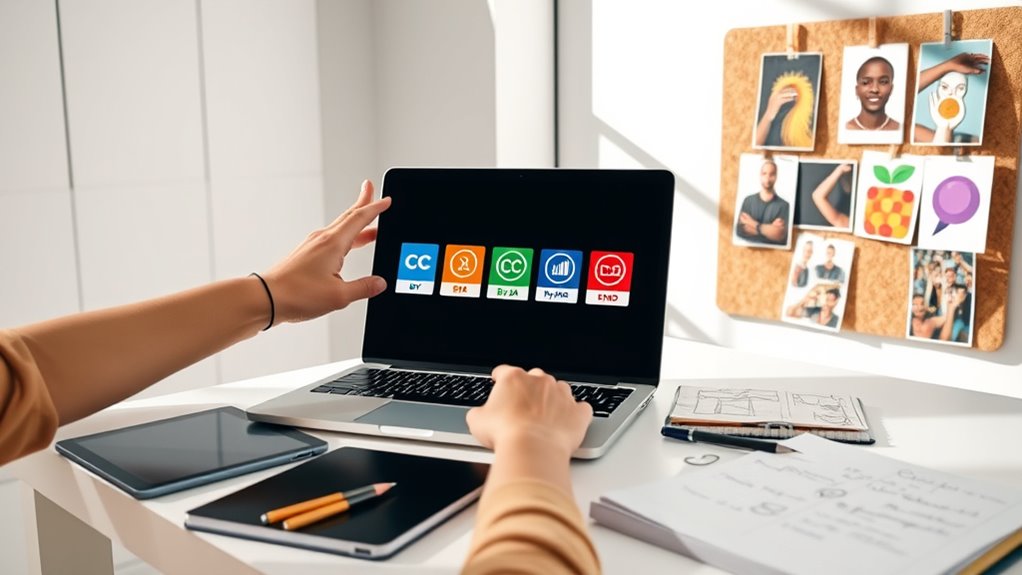
Understanding the six main types of Creative Commons licenses helps you know what you can legally use and share. You’ll see how license variations affect permissible usage limits and what attribution is required. This clarity guarantees you respect creators’ rights while leveraging shared content effectively. Familiarity with license categories ensures proper compliance and appropriate attribution in your projects.
License Variations Overview
Have you ever wondered how different licenses shape the way you can use or share creative works? Creative Commons offers six main license types, each with unique variations. These licenses differ mainly in three ways:
- Attribution (BY) – You can use the work as long as you credit the creator.
- ShareAlike (SA) – You can remix or adapt, but must share under the same license.
- NonCommercial (NC) – The work can only be used for non-commercial purposes.
Some licenses combine these features, like CC BY-NC or CC BY-SA. Others, like CC0, waive all rights, allowing unrestricted use. Understanding these variations helps you choose the right license and respect creators’ intentions effectively. For creators, understanding relationships and communication can influence how they license their work and engage with users. Additionally, recognizing the emotional journey of decluttering can help creators feel more confident when sharing or licensing their work, knowing they are respecting their own boundaries and intentions.
Permissible Usage Limits
Each of the six main Creative Commons licenses sets clear limits on how you can utilize the work. These limits specify what you’re permitted or restricted from doing. Some licenses allow you to copy, distribute, and modify the work freely, as long as you follow certain conditions. Others restrict commercial use or require that you share any derivative works under the same license. For example, the CC BY license lets you use the work broadly, but CC BY-NC restricts use to non-commercial purposes. Understanding these limits helps you avoid unintentional infringement. Additionally, the contrast ratio of a work can influence its visual clarity and impact, which is especially relevant for visual content creators. Ensuring the license type aligns with your intended use is crucial to comply with legal requirements. Recognizing the scope of permitted modifications can prevent unintended violations and help you adapt content appropriately. The compatibility between licenses is also important to consider when combining multiple licensed works. Being aware of the personality traits associated with certain license choices can also guide you in making ethical and suitable selections. Always check which license applies to ensure your usage aligns with its permissions and restrictions. This way, you respect the creator’s intentions while making the most of the available rights.
Attribution Requirements
What do you need to do if you want to legally share work under a Creative Commons license? You must give proper attribution to the creator. This means crediting them clearly and accurately. Here are the key steps:
- Credit the creator by name or pseudonym as specified.
- Provide the license type to inform others of the specific permissions.
- Include a link to the license or the original work, if possible.
- Be aware that some licenses, like those for electric bikes, may have additional requirements or restrictions.
- When sharing, consider the health benefits of juices that support overall wellness, highlighting the importance of responsible sharing of content related to health. Additionally, understanding Creative Commons licensing helps ensure respectful and lawful use of shared content. Being aware of the different Vetted license types can help you select the appropriate license for your work and ensure compliance.
Understanding Attribution: Giving Credit Where It’s Due
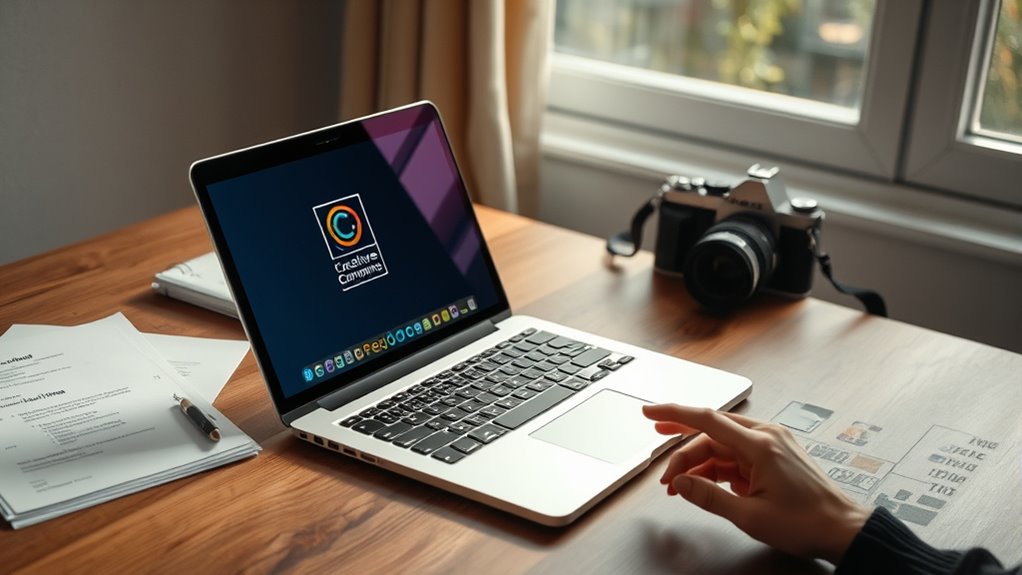
Why is giving proper credit essential when using Creative Commons-licensed works? Because attribution acknowledges the original creator’s effort and respects their rights. When you use someone’s work, you’re benefiting from their creativity, so it’s only fair to give them credit. Proper attribution also helps others find the original source, encouraging a community of sharing and collaboration. Make sure to include the creator’s name, the title of the work, and the license type. Sometimes, you might need to provide a link to the original, or indicate if modifications were made. By giving clear and accurate credit, you honor the creator’s rights, avoid copyright issues, and demonstrate your professionalism as a designer committed to ethical practices.
Exploring ShareAlike and Its Implications for Your Projects
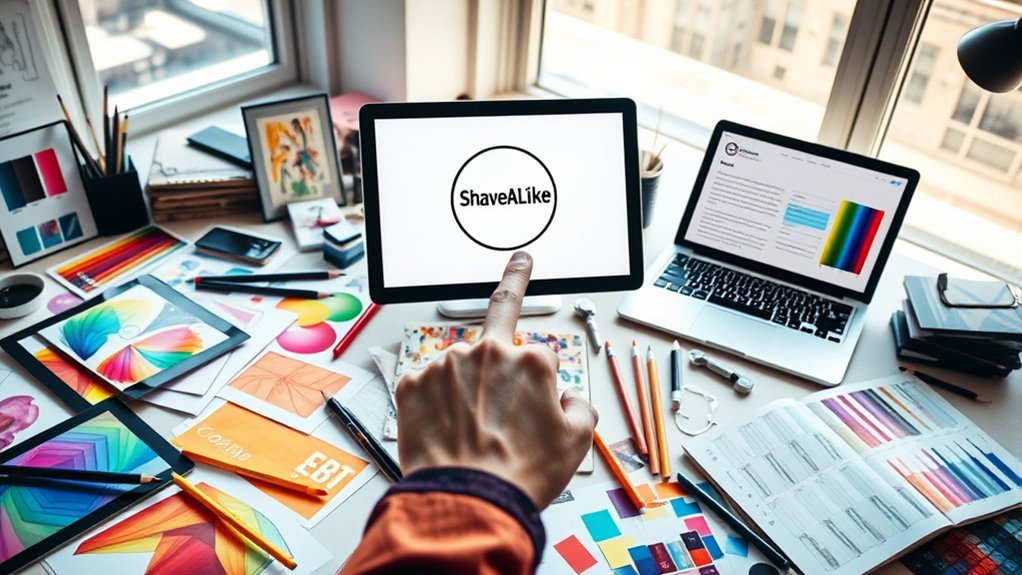
ShareAlike requires you to license derivative works under the same or a compatible license, encouraging open collaboration. This can foster creative teamwork but may also limit your flexibility if you want to keep certain elements proprietary. Additionally, compatibility issues can arise when combining ShareAlike-licensed content with other licenses, so it’s crucial to weigh how it fits into your project.
ShareAlike Definition and Purpose
Have you ever wondered how ShareAlike licenses influence the way you can reuse and adapt creative works? ShareAlike (SA) is a license that requires you to release any derivative works under the same or a compatible license. Its purpose is to guarantee that adaptations remain open and accessible, promoting a cycle of sharing and collaboration. When you use SA-licensed content, you agree to:
- Keep the modified work under the same ShareAlike license.
- Attribute the original creator properly.
- Distribute any derivatives with the same licensing terms.
This approach helps maintain the openness of creative works, encouraging ongoing innovation while respecting original authors’ rights. By understanding ShareAlike, you can confidently build upon existing content while supporting a collaborative creative community.
Creative Collaboration Considerations
When you incorporate ShareAlike licensed content into your projects, it’s essential to contemplate how this license shapes your collaboration strategies. ShareAlike requires that any derivative works you create also be shared under the same license, which encourages open sharing but limits your flexibility. You need to communicate clearly with collaborators about licensing expectations and ensure everyone understands the obligation to license derivatives similarly. This openness fosters community contributions and ongoing reuse, but it may also restrict your ability to combine content with more restrictive licenses. Planning your projects with ShareAlike in mind helps you avoid legal complications and maintains transparency. Ultimately, embracing ShareAlike cultivates a collaborative environment where creative work can evolve and be freely shared, benefiting the entire community.
Licensing Compatibility Challenges
While sharing content under ShareAlike licenses promotes openness and collaboration, it can also introduce significant compatibility challenges with other licensing types. These challenges may limit how you combine or reuse works. For example:
- Some licenses, like All Rights Reserved, aren’t compatible with ShareAlike, preventing seamless integration.
- When mixing multiple licensed works, you might need to choose only compatible licenses, restricting your options.
- Certain jurisdictions interpret ShareAlike terms differently, complicating international projects.
Understanding these issues helps you plan your projects more effectively. You may need to carefully select licenses to ensure compatibility or avoid combining certain works altogether. Recognizing these challenges allows you to protect your creative freedom while respecting license terms.
NonCommercial and NoDerivatives: What Restrictions Might Apply?

Understanding the restrictions of NonCommercial and NoDerivatives licenses is essential for using Creative Commons-licensed works responsibly. With a NonCommercial license, you can’t use the work for profit or commercial gain. This means you must avoid selling it or using it in advertising. NoDerivatives means you can’t modify, adapt, or build upon the original work. If you remix or change it, you need to share the new version under the same license, or not at all, depending on the license terms. These restrictions ensure the creator’s intentions are respected. Always check the license details carefully, as some licenses combine both restrictions, limiting how you can use the work. Understanding these limitations helps you avoid legal issues and use creative content ethically.
How to Properly Use and Attribute Creative Commons Works
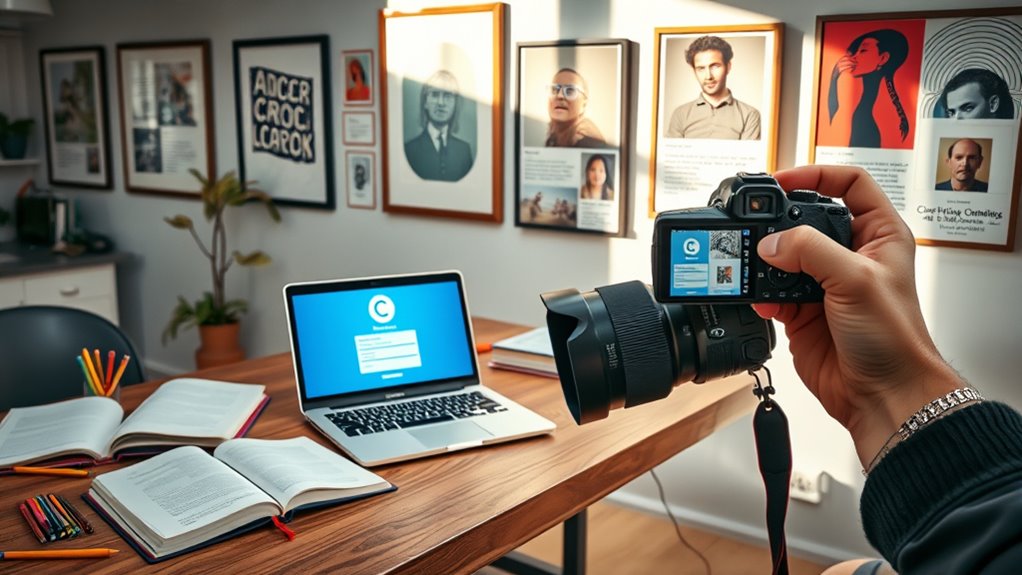
Using Creative Commons works responsibly starts with proper attribution. To do this effectively, follow these steps:
Proper attribution ensures respectful and lawful use of Creative Commons works.
- Identify the creator and license type: Always check who created the work and verify the specific CC license to understand your obligations.
- Give clear credit: Include the creator’s name, the title of the work, and a link to the original source whenever possible.
- Follow license requirements: Respect any restrictions, such as non-commercial use or attribution format, specified by the license.
Common Mistakes to Avoid When Using Licensed Content

One common mistake is failing to fully understand the specific terms of a Creative Commons license, which can lead to unintentional misuse. Not all CC licenses allow commercial use, adaptations, or even attribution in the same way. To avoid this, always check the license details carefully before using content. Misinterpreting restrictions can result in legal issues or damaged reputation. For example:
| License Type | Allowed Uses | Restrictions |
|---|---|---|
| CC BY | Commercial, modifications | Attribution required |
| CC BY-SA | Share alike, commercial | Share adaptations under same license |
| CC BY-ND | No derivatives, commercial | No modifications allowed |
| CC BY-NC | Non-commercial use | No commercial activities |
| CC BY-NC-SA | Non-commercial, share alike | Cannot use commercially or modify freely |
Best Practices for Incorporating Creative Commons Materials Into Your Designs
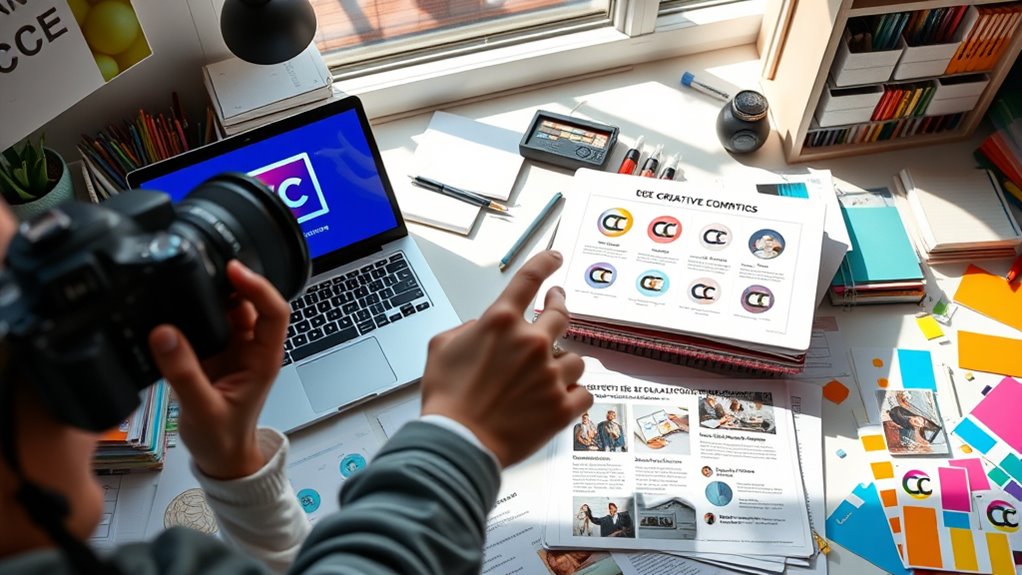
Incorporating Creative Commons materials into your designs requires more than just finding freely available content; it involves applying best practices to respect licensing terms and guarantee proper attribution. First, always read and understand the specific license associated with each piece to ensure you comply with its requirements. Second, give clear attribution by including the creator’s name, the license type, and a link to the source, following the recommended format. Third, verify if your intended use aligns with the license’s permissions, especially for commercial projects or modifications. By following these steps, you respect creators’ rights and avoid legal issues. Consistently practicing these best practices helps you responsibly incorporate Creative Commons materials into your work, maintaining integrity and fostering a respectful creative community.
Resources and Tools for Managing Creative Commons Licenses
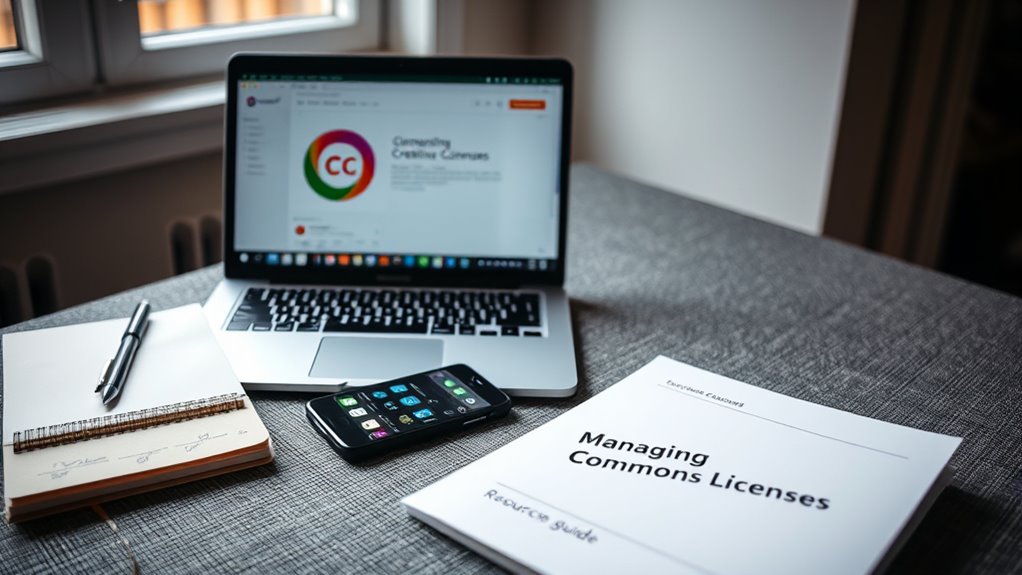
Managing Creative Commons licenses can be complex, but thankfully, there are a variety of resources and tools designed to simplify the process. Platforms like Creative Commons’ own license chooser help you select the right license for your work. Tools such as CC Search allow you to find content that’s properly licensed and safe to use. Metadata management tools like EXIF and IPTC embed licensing rights directly into your files, making it clear how others can use your work. License tracking apps can also help you keep tabs on multiple licenses across projects. Additionally, online tutorials and communities provide support and guidance, ensuring you understand licensing terms. These resources empower you to confidently manage licenses, avoid legal pitfalls, and respect creators’ rights.
Frequently Asked Questions
Can I Modify Creative Commons Licensed Content Without Violating the License Terms?
You can modify Creative Commons licensed content if the license permits adaptations, such as CC BY or CC BY-SA. Always check the specific license terms; some require attribution, share-alike, or prohibit commercial use. When you modify the work, you must follow these rules and clearly credit the original creator. If the license allows, you’re free to adapt, remix, or build upon the content without violating the license.
How Do I Verify the License Status of a Creative Commons Work?
You’re on the right track by asking how to verify a Creative Commons license. First, check the source where you found the work—look for clear licensing information or icons. Always read the specific license details, as rules vary. Don’t assume a work is free to use; when in doubt, contact the creator. Remember, a little caution saves you from potential legal headaches down the line.
Are There Any Legal Risks if I Misuse Creative Commons Licenses?
If you misuse Creative Commons licenses, you risk legal trouble, including lawsuits or fines. You might unintentionally infringe on copyright if you don’t follow license terms like attribution or usage restrictions. Always double-check the license details before using a work, and verify you meet all conditions. Failing to do so can lead to copyright claims, damaging your reputation and possibly resulting in legal penalties.
How Do International Copyright Laws Affect Creative Commons Licensing?
International copyright laws can complicate Creative Commons licensing because each country has its own rules and enforcement methods. When you use or share licensed content globally, you might face legal issues if local laws differ or if the license isn’t recognized. To stay safe, you should always check the specific license terms and consider how they apply across different jurisdictions. This way, you avoid unintentional violations and protect your work internationally.
What Should I Do if I Encounter Ambiguous or Unclear License Terms?
Oh, great, you’ve found an unclear license—what could go wrong? First, don’t use or modify the work until you’re sure about the terms. Reach out to the creator for clarification, or seek legal advice if needed. It’s tempting to guess, but ambiguities can lead to legal trouble. Always prioritize clear, documented permissions to protect your work and reputation. Better safe than sorry!
Conclusion
Understanding Creative Commons licenses empowers you to use resources responsibly and creatively. By respecting attribution, restrictions, and best practices, you avoid legal pitfalls and foster respect within the design community. Remember, “honesty is the best policy”—give credit where it’s due and follow license terms diligently. With these tools and knowledge, you can confidently incorporate licensed works into your projects, turning limitations into opportunities and creating designs that are both ethical and inspiring.









